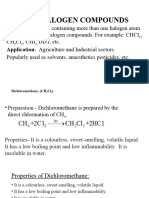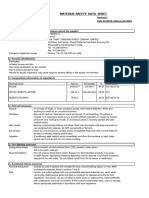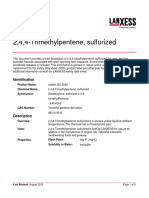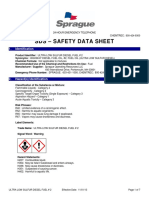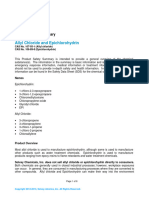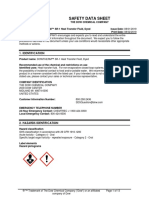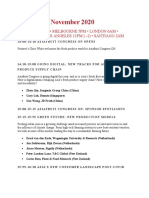Trichloroethylene - Safety Datasheet
Trichloroethylene - Safety Datasheet
Uploaded by
lutzzCopyright:
Available Formats
Trichloroethylene - Safety Datasheet
Trichloroethylene - Safety Datasheet
Uploaded by
lutzzOriginal Title
Copyright
Available Formats
Share this document
Did you find this document useful?
Is this content inappropriate?
Copyright:
Available Formats
Trichloroethylene - Safety Datasheet
Trichloroethylene - Safety Datasheet
Uploaded by
lutzzCopyright:
Available Formats
Product Safety Assessment
Trichloroethylene
Select a Topic:
Names
Product Overview
Manufacture of Product
Product Description
Product Uses
Exposure Potential
Health Information
Environmental Information
Physical Hazard Information
Regulatory Information
Additional Information
References
Names
CAS No. 79-01-6 Tri
Trichloroethylene Trichlor
1,1,2-trichloroethylene Tric
Ethylene Trichloride HI-TRI* Solvent
Trichloroethene HI-TRI SMG Solvent
Ethinyl trichloride NEU-TRI* Solvent
Acetylene trichloride NEU-TRI E Solvent
TCE NEU-TRI L Solvent
Product Overview
Trichloroethylene is a nonflammable, colorless liquid with a sweet odor.1 See Product
Description.
Trichloroethylene is used mainly as a solvent to remove grease from metal parts. It is also
1
used as a general solvent and as an intermediate to make other chemicals. See Product
Uses.
Persons working with trichloroethylene should be provided with and instructed in the use of
appropriate personal protective clothing and equipment, as required. Adequate ventilation
should be provided in the workplace to minimize the possibility of inhalation, which may be
hazardous. See Exposure Potential.
Trichloroethylene is moderately toxic if swallowed. Due to trichloroethylene’s volatility,
inhalation is the principal route of exposure. The initial effects of excessive inhalation
exposure are dizziness, loss of coordination, sleepiness and symptoms of anesthesia.
Excessive exposure may cause systemic injury or even death. The National Toxicology
Program (NTP) has classified trichloroethylene as “reasonably anticipated to be a human
carcinogen” and in 2013 the International Agency for Research on Cancer (IARC) changed
2,3
the classification from “probably carcinogenic to humans” to “carcinogenic to humans See
Health Information.
Because trichloroethylene evaporates easily, if it is released to the environment during
production and use, most of it eventually reaches the air. Trichloroethylene that reaches
groundwater may be difficult to remediate. Trichloroethylene is moderately toxic to aquatic
organisms and does not bioaccumulate. See Environmental Information.
®TM
*Trademark of The Dow Chemical Company (“Dow”) or an affiliated company of Dow
Revised: July 3, 2014 The Dow Chemical Company Page 1 of 6
Product Safety Assessment: Trichloroethylene
Trichloroethylene may thermally decompose upon exposure to open flames or hot surfaces.
Involvement of trichloroethylene in a fire can result in the formation of toxic gases, including
2
hydrogen chloride, chlorine, and phosgene. See Physical Hazard Information.
Back to top
Manufacture of Product
4
Capacity – Dow is one of two companies that produce trichloroethylene in the United States.
Dow produces trichloroethylene in Freeport, Texas. In 20 2011,, global consumption of
trichloroethylene was 429,5 500 metric tons (947 million pounds) versus global production
capacity of 547,000
,000 metric tons (1,
(1,206 million pounds).
1,5
Process – Dow produces trichloroethylene by a direct chlorination process, in which
ethylene dichloride or other CC2 chlorinated hydrocarbons are reacted with chlorine to form
trichloroethylene and tetrachloroethylene
tetrachloroethylene,, which are then separated by distillation.
distillation The
“TRI/PER” process uses the light fractions of the residues from the manufacture of vinyl
chloride as its major raw material.
Back to top
Product Description
Trichloroethylene
thylene is a clear, heavy liquid with excellent solvency. Trichloroethylene has no flash
point as determined by standard test methods. Its stability in the presence of common chemical
stabilizers and low boiling point permit vapor degreasing with low heat input. Easily recycled, the
6
solvent combines outstanding cleaning power with greater economy.
Back to top
Uses for Trichloroethylene7
Product Uses7,8,9
Trichloroethylene is an excellent Other
solvent
lvent for greases, oils, fats, w
waxes, 5%
and tars. Therefore most of its global
use is as a solvent for metal cleaning
Chemical
(degreasing) and across many other
Solvent intermediate
applications such as nonflammable
applications for HFCs
adhesive formulations, as a low low-
60% 35%
temperature heat-transfer
transfer medium
medium, and
as a solvent in waterless dying and
finishing operations. Trichloroethylene
is also used in the production of lithium
ion batteries, polychlorinated aliphatics and certain flame
flame-retardant chemicals. Inn the manufacture
of polyvinyl chloride (PVC), trichloroethylene is used as a molecular weight control agent.
Trichloroethylene is also used extensively as a chemical intermediate in the synthesis of
hydrofluorocarbon (HFC) refrigerants, blowing agents
agents, and d some agricultural chemicals.
Back to top
Exposure Potential2
Trichloroethylene is used in the production of industrial products and in industrial processes. The
people most likely to be exposed to increased levels of trichloroethylene in the air are those
t who
work in chemical facilities where it is made or used. Inhalation of vapors from trichloroethylene or
products containing trichloroethylene should be minimized. Based on the uses for
trichloroethylene, the public could be exposed through:
Revised: July 3, 2014 The Dow Chemical Company Page 2 of 6
Product Safety Assessment: Trichloroethylene
Workplace exposure – Exposure can occur either in a trichloroethylene manufacturing
facility or in the various industrial or manufacturing facilities that use trichloroethylene.
Trichloroethylene should be produced, distributed, stored, and used in closed systems.
Those working with trichloroethylene in manufacturing operations could be exposed during
maintenance, sampling, testing, or other procedures. Each manufacturing facility should have
a thorough training program for employees and appropriate work processes and safety
equipment in place to limit unnecessary trichloroethylene exposure. Persons working with
trichloroethylene should be provided with and instructed in the use of appropriate personal
protective clothing and equipment, as required. Adequate ventilation should be provided in
the workplace to minimize the possibility of an inhalation hazard. Clothing items that cannot
be decontaminated—such as shoes, belts, and watchbands—should be removed and
disposed of properly after exposure. See Health Information.
Consumer exposure to products containing trichloroethylene – Dow does not sell
trichloroethylene for direct consumer use. See Health Information.
Environmental releases – In the event of a spill, focus on containing the spill to prevent
contamination of soil, surfaces or ground water. Mop or soak up the material immediately.
Absorb with vermiculite or sawdust. Respiratory protection is necessary for cleaning up spills
and leaks. Eliminate all sources of ignition immediately. Although trichloroethylene itself does
not have a flash point, it can burn at room temperature. Ventilate the area of the leak or spill.
Isolate the area until the vapor has dispersed. See Environmental Information, Health
Information, and Physical Hazard Information.
Large release – Industrial spills or releases are infrequent and generally contained. If a large
spill does occur, the material should be captured, collected, and reprocessed or disposed of
according to applicable governmental requirements. Positive pressure, self-contained
breathing apparatus (SCBA) with a full-face mask approved by NIOSH is recommended for
emergency work. Eliminate all sources of ignition immediately. Use only explosion-proof
equipment; ground and bond all containers and handling equipment. In case of fire, deny any
unnecessary entry into the area. Use water fog or fine spray. Avoid contact with this material
during fire-fighting operations. If contact is likely, change to full chemical-resistant fire-fighting
clothing with SCBA. During a fire, smoke may contain the original material in addition to
combustion products of varying composition, which may be toxic and/or irritating. Clear non-
emergency personnel from the area. Vapors are heavier than air and may travel a long
distance and accumulate in low-lying areas. The public should be warned of downwind vapor
explosion hazards. Keep vapors out of sewers. Follow emergency procedures carefully. See
Environmental Information, Health Information, and Physical Hazard Information.
For more information, see the relevant Safety Data Sheet.
Back to top
Health Information1,2,3
Brief contact may cause moderate skin irritation with local redness. Lengthy or repeated exposure
may cause irritation and drying or flaking of the skin. Prolonged or widespread skin contact is
unlikely to result in absorption of harmful amounts. Trichloroethylene may be absorbed through
the skin and may cause numbness in fingers immersed in the liquid.
Very low toxicity if swallowed. However, if swallowed, do not induce vomiting.
Inhalation is the principal route of exposure for trichloroethylene. The initial effects of excessive
inhalation exposure are dizziness, loss of coordination, sleepiness, and symptoms of anesthesia.
Nausea may accompany these signs and symptoms. Excessive exposure may cause systemic
injury (even death) and may increase sensitivity to epinephrine and increase the probability of
irregular heartbeats. Do not administer sympathomimetic drugs (like epinephrine) unless
absolutely necessary. Trichloroethylene exposure may also cause alcohol intolerance, which
often causes temporary reddening of the skin (“degreaser’s flush”). Health effects have been
Revised: July 3, 2014 The Dow Chemical Company Page 3 of 6
Product Safety Assessment: Trichloroethylene
reported when people are exposed to the level of trichloroethylene at which its odor is noticeable.
Effects reported at high levels include liver and kidney damage and changes in heart beat.
Several studies with mice and rats have suggested that high doses of trichloroethylene may
cause liver, kidney, or lung cancer. The National Toxicology Program (NTP) has classified
trichloroethylene as “reasonably anticipated to be a human carcinogen” and the International
Agency for Research on Cancer (IARC) has listed it as “carcinogenic to humans” or Group 1.
Trichloroethylene has not caused birth defects in animal studies. Male reproductive toxicity
effects were observed in laboratory animals in the presence of systemic toxicity at high. In vitro
genetic toxicity studies were negative, and animal genetic toxicity studies were predominantly
negative. Pure trichloroethylene (without additives) lacks genetic toxicity potential in most test.
For more information, see the relevant Safety Data Sheet.
Back to top
Environmental InformationError! Bookmark not defined.,5
Because it evaporates easily, most of the trichloroethylene released to the environment (either
during production or use) reaches the air, where it is found mainly as a gas. Even material that is
in water will readily evaporate into the air. However, trichloroethylene is moderately toxic to
aquatic organisms. Trichloroethylene that reaches groundwater may be difficult to remediate.
Trichloroethylene is not considered readily biodegradable, although biodegradation may occur
slowly under both aerobic and anaerobic conditions. The potential mobility of trichloroethylene in
the soil is high. Very little trichloroethylene breaks down in soil, and it can pass through the soil
into underground water. It does not bioaccumulate (build up in the food chain).
For more information, see the relevant Safety Data Sheet.
Back to top
Physical Hazard Information2
Trichloroethylene is thermally stable at typical use temperatures. Thermal decomposition may
occur if the material is near open flames or hot sources. Toxic gases can be released during fire
or decomposition. The decomposition products depend upon temperature, air supply, and the
presence of other materials, but can include hydrogen chloride, chlorine, and phosgene.
Avoid contact of trichloroethylene with alkali metal hydroxides and strong bases. It can react to
form dichloroacetylene, which can spontaneously ignite in air. Avoid contact of trichloroethylene
with strong oxidizers.
For more information, see the relevant Safety Data Sheet.
Back to top
Regulatory Information
Regulations may exist that govern the manufacture, sale, transportation, use, and/or disposal of
trichloroethylene. These regulations may vary by city, state, country, or geographic region.
Information may be found by consulting the relevant Safety Data Sheet or Technical Data Sheet.
Back to top
Revised: July 3, 2014 The Dow Chemical Company Page 4 of 6
You might also like
- Material Safety Data Sheet: TrichloroethyleneDocument6 pagesMaterial Safety Data Sheet: TrichloroethylenefructoraNo ratings yet
- Trimethyl Borate: Product Safety AssessmentDocument5 pagesTrimethyl Borate: Product Safety AssessmentBobyEsterandoNo ratings yet
- TrimethylolpropaneDocument3 pagesTrimethylolpropaneeliteindustries.pkNo ratings yet
- Polyhalogen CompoundsDocument18 pagesPolyhalogen CompoundscherrydevmNo ratings yet
- Polyhalogen CompundsDocument7 pagesPolyhalogen CompundsKrithick KumarNo ratings yet
- Material Safety Data Sheet: XyleneDocument6 pagesMaterial Safety Data Sheet: XylenefructoraNo ratings yet
- Trichloroethylene: You Could Be Exposed To Trichloroethylene ThroughDocument2 pagesTrichloroethylene: You Could Be Exposed To Trichloroethylene ThroughAhmed AzadNo ratings yet
- TUS Inhalantes GoldfranksDocument10 pagesTUS Inhalantes GoldfranksDavid Andrés BravoNo ratings yet
- Hypalon 4085 Spec SheetDocument18 pagesHypalon 4085 Spec SheetpadrititaNo ratings yet
- Solventvapourdegreasing 1989 PDFDocument25 pagesSolventvapourdegreasing 1989 PDFmoonstarNo ratings yet
- Material Safety Data Sheet: Tetramethyl LeadDocument6 pagesMaterial Safety Data Sheet: Tetramethyl LeadfructoraNo ratings yet
- Toluene DiisocyanateDocument8 pagesToluene DiisocyanateKaka BabaNo ratings yet
- Manufacture of TrifluralinDocument49 pagesManufacture of TrifluralinAhmed Ali0% (1)
- DOWANOLTM DPM Glycol EtherDocument5 pagesDOWANOLTM DPM Glycol EtherNanang BumimasNo ratings yet
- T2labaratories, Risk AnalysisDocument18 pagesT2labaratories, Risk AnalysisThomas Bollen100% (1)
- 2017 Sadr Lab SOPsDocument9 pages2017 Sadr Lab SOPsEsamKhalilAlQadiNo ratings yet
- Nitromethane: Product Safety AssessmentDocument7 pagesNitromethane: Product Safety AssessmentOscar Eduardo SilvaNo ratings yet
- Polyhalogen CompundsDocument17 pagesPolyhalogen Compundsanaysomani1805No ratings yet
- Vulkacit ThiuramDocument4 pagesVulkacit Thiuramdiamondtyre111No ratings yet
- Triethylene Glycol HP (MSDS)Document8 pagesTriethylene Glycol HP (MSDS)dmbets15No ratings yet
- Alkil HalidaDocument10 pagesAlkil HalidaFanny sembiringNo ratings yet
- Trichlorofluoromethane: 24/7 Emergency Contact Number: 1-888-295-5156Document2 pagesTrichlorofluoromethane: 24/7 Emergency Contact Number: 1-888-295-5156redof markzNo ratings yet
- THF MSDSDocument6 pagesTHF MSDSCarl Samuel ReyesNo ratings yet
- UNITIII StructureandUsesofAlkylhalidesDocument10 pagesUNITIII StructureandUsesofAlkylhalidesPradhyumn ShivhareNo ratings yet
- Trichloroacetic AcidDocument10 pagesTrichloroacetic Acidwillyvh99No ratings yet
- Polyhalogen CompoundsDocument10 pagesPolyhalogen CompoundsBellatrix LestrangeNo ratings yet
- Msds Cl2Document12 pagesMsds Cl2Ganjar Tri Gita AzhariNo ratings yet
- Poly-Halogen CompoundsDocument2 pagesPoly-Halogen CompoundsjjknarutotokyoNo ratings yet
- Material Safety Data Sheet: Nitrogen TrifluorideDocument6 pagesMaterial Safety Data Sheet: Nitrogen TrifluoridefructoraNo ratings yet
- Toluene: Safety Data SheetDocument85 pagesToluene: Safety Data SheetDaniel MartinsNo ratings yet
- 786 CPVC Cement SDSDocument9 pages786 CPVC Cement SDSeslam sokaNo ratings yet
- Msds Fluorodyn Viton AdhesiveDocument12 pagesMsds Fluorodyn Viton AdhesivemontsegranNo ratings yet
- Guidelines For Open Plant StructuresDocument6 pagesGuidelines For Open Plant StructuresIndrawNo ratings yet
- Methylene Chloride: Safety Data SheetDocument5 pagesMethylene Chloride: Safety Data SheetAnuj Kumar Mishra100% (1)
- Gps Summary ChlorineDocument5 pagesGps Summary ChlorinehamidNo ratings yet
- Gps Safety Summary 2 Methoxy 4 NitroanilineDocument6 pagesGps Safety Summary 2 Methoxy 4 NitroanilineGOHIL HARDEEPSINHNo ratings yet
- Msds - Thinner CMP31 - Rev 1Document4 pagesMsds - Thinner CMP31 - Rev 1tiennv.blcmNo ratings yet
- 244trimethylpentene SulfurizedDocument3 pages244trimethylpentene Sulfurizedarmin.sosNo ratings yet
- MSDS Methanol Eng-1276 PDFDocument59 pagesMSDS Methanol Eng-1276 PDFAlbert GuiNo ratings yet
- Safety Data Sheet: Chevron (Hong Kong) Euro V DieselDocument12 pagesSafety Data Sheet: Chevron (Hong Kong) Euro V DieselKanthan DevanNo ratings yet
- CARBOWAX Polyethylene Glycol 1450 Molten-Safety Data Sheet-EnDocument10 pagesCARBOWAX Polyethylene Glycol 1450 Molten-Safety Data Sheet-Endeddy.pandamasNo ratings yet
- Material Safety Data Sheet: Vinyl AcetateDocument6 pagesMaterial Safety Data Sheet: Vinyl AcetatefructoraNo ratings yet
- Thionyl ChlorideDocument6 pagesThionyl ChlorideANKUSH SINGHNo ratings yet
- Material Safety Data Sheet: 1. Product InformationDocument5 pagesMaterial Safety Data Sheet: 1. Product Informationsushant_jhawerNo ratings yet
- Triethylene Glycol SdsDocument8 pagesTriethylene Glycol SdsAbhishek DoshiNo ratings yet
- Ultra Low Sulfur Diesel Fuel 2 SdsDocument7 pagesUltra Low Sulfur Diesel Fuel 2 SdsroberthvcNo ratings yet
- Tetrahydrofuran: Technical InformationDocument3 pagesTetrahydrofuran: Technical InformationNavieenNo ratings yet
- MSDSDocument27 pagesMSDSNgọc Vũ MinhNo ratings yet
- DieselDocument12 pagesDieselikaNo ratings yet
- PSS Allyl Chloride EpichlorohydrinDocument6 pagesPSS Allyl Chloride EpichlorohydrinOmar QasimNo ratings yet
- Environmental, Health, and Safety OverviewDocument11 pagesEnvironmental, Health, and Safety OverviewBradSiefkerNo ratings yet
- Etyl Mercaptan MSDSDocument24 pagesEtyl Mercaptan MSDSmostafa_1000100% (1)
- Reactions of CMMEDocument6 pagesReactions of CMMEHafeez WazirNo ratings yet
- Dowtherm SR-1 (Ingles)Document13 pagesDowtherm SR-1 (Ingles)Jana DmitrievaNo ratings yet
- Shell Tellus Oil T 32: Safety Data SheetDocument8 pagesShell Tellus Oil T 32: Safety Data SheetTiago GodinhoNo ratings yet
- Safety Data Sheet: 1. IdentificationDocument12 pagesSafety Data Sheet: 1. Identificationanon_444174592No ratings yet
- A500 MSDSDocument6 pagesA500 MSDSHandan adminNo ratings yet
- Polyhalogen CompoundsDocument3 pagesPolyhalogen CompoundsHadiya FatimaNo ratings yet
- Dust Explosion and Fire Prevention Handbook: A Guide to Good Industry PracticesFrom EverandDust Explosion and Fire Prevention Handbook: A Guide to Good Industry PracticesNo ratings yet
- Woodward - Gas Stop Ratio ValveDocument54 pagesWoodward - Gas Stop Ratio ValvelutzzNo ratings yet
- INS DS 0058 Buckling Pin Pressure Relief ValveDocument12 pagesINS DS 0058 Buckling Pin Pressure Relief ValvelutzzNo ratings yet
- Internal ACME Thread General Purpose Size ChartDocument12 pagesInternal ACME Thread General Purpose Size ChartlutzzNo ratings yet
- Delayed Coker Metal-Seated Ball Valves: Installation and Operation ManualDocument36 pagesDelayed Coker Metal-Seated Ball Valves: Installation and Operation ManuallutzzNo ratings yet
- Internal ACME Thread General Purpose Size ChartDocument12 pagesInternal ACME Thread General Purpose Size ChartlutzzNo ratings yet
- Instrumentarium Dental OP-200D, OC-200D Dental Panorama X-Ray - User ManualDocument154 pagesInstrumentarium Dental OP-200D, OC-200D Dental Panorama X-Ray - User ManualmariaNo ratings yet
- Master Thesis Agriculture PDFDocument6 pagesMaster Thesis Agriculture PDFBuySchoolPapersSingapore100% (1)
- A12 Prevmed Flashcards Oct 2022Document5 pagesA12 Prevmed Flashcards Oct 2022edgarciaNo ratings yet
- Ihr Port ListDocument98 pagesIhr Port ListcipNo ratings yet
- Activity Design RefereesDocument2 pagesActivity Design RefereesGlorife RiveralNo ratings yet
- Tuesday 17 November 2020: Singapore 2Pm - Melbourne 5Pm - London 6am - Berlin 7am - Los Angeles 11Pm (-1) - Santiago 2amDocument2 pagesTuesday 17 November 2020: Singapore 2Pm - Melbourne 5Pm - London 6am - Berlin 7am - Los Angeles 11Pm (-1) - Santiago 2amThuan DuongNo ratings yet
- Flipkart HRMDocument14 pagesFlipkart HRMNaman GuptaNo ratings yet
- Revolutionizing Coconut Milk Production 2023 PDFDocument7 pagesRevolutionizing Coconut Milk Production 2023 PDFBenedict ReductoNo ratings yet
- A Level Sport CourseworkDocument8 pagesA Level Sport Courseworkafjzdonobiowee100% (2)
- Case Study Research: An IntroductionDocument13 pagesCase Study Research: An IntroductionKanupriyamNo ratings yet
- Webinar FlyerDocument1 pageWebinar FlyerJoy DublasNo ratings yet
- RVNV Xibmi Wek We' VJQ: Mvfvi, XVKVDocument20 pagesRVNV Xibmi Wek We' VJQ: Mvfvi, XVKVGuluNo ratings yet
- National Patient Safety AwardDocument35 pagesNational Patient Safety AwardAR cerezaNo ratings yet
- Carrier Oil: Massage Oil (Olive Oil)Document1 pageCarrier Oil: Massage Oil (Olive Oil)Dilruba UmiNo ratings yet
- Clinically Organized Relevant Exam CORE Neck Tool EditedDocument9 pagesClinically Organized Relevant Exam CORE Neck Tool EditedGeorge wrightNo ratings yet
- The Divorce Recovery BookDocument217 pagesThe Divorce Recovery BooktheskysthelimitcreditrepairNo ratings yet
- ESL-Brains-Are-you-ever-too-young-for-greatness-SV-8448Document2 pagesESL-Brains-Are-you-ever-too-young-for-greatness-SV-8448Sebastian GrabskiNo ratings yet
- Foreign Studies-RRSDocument9 pagesForeign Studies-RRSRona CabanyogNo ratings yet
- Internal Audit Report - 01Document4 pagesInternal Audit Report - 01Daniel Idongesit100% (4)
- Primary Angle-Closure Glaucoma: 1. Pathogenesis 2. ClassificationDocument9 pagesPrimary Angle-Closure Glaucoma: 1. Pathogenesis 2. ClassificationkhadzxNo ratings yet
- Introduction To Diet Therapy - Syllabus - 13Document5 pagesIntroduction To Diet Therapy - Syllabus - 13Amany SalamaNo ratings yet
- Perspective in Dentistry Reviewer (PH)Document3 pagesPerspective in Dentistry Reviewer (PH)Jas Jas100% (1)
- Psychosocial Activities Junior High SchoolDocument29 pagesPsychosocial Activities Junior High SchoolRosarie CharishNo ratings yet
- 1-ADMS 2400 A Favaro Syllabus Falll 2019Document8 pages1-ADMS 2400 A Favaro Syllabus Falll 2019Anita SharmaNo ratings yet
- DietDocument20 pagesDietShyra Jane DolosoNo ratings yet
- Sol3e Uppint Short Test Answer Keys BDocument7 pagesSol3e Uppint Short Test Answer Keys Bлюблю овервотч67% (6)
- Ova NCP JameaDocument5 pagesOva NCP JameaDanica CumlatNo ratings yet
- Expediente Sanitario Nombre Producto Registro Sanitario Vencimiento Modalidad Estado Registro ObservacionesDocument3 pagesExpediente Sanitario Nombre Producto Registro Sanitario Vencimiento Modalidad Estado Registro Observacionesjuan alberto florez coteNo ratings yet
- Spinal ImmobilisationDocument34 pagesSpinal ImmobilisationGunther BielenNo ratings yet
- NCP PryllDocument6 pagesNCP PryllpjcolitaNo ratings yet

















